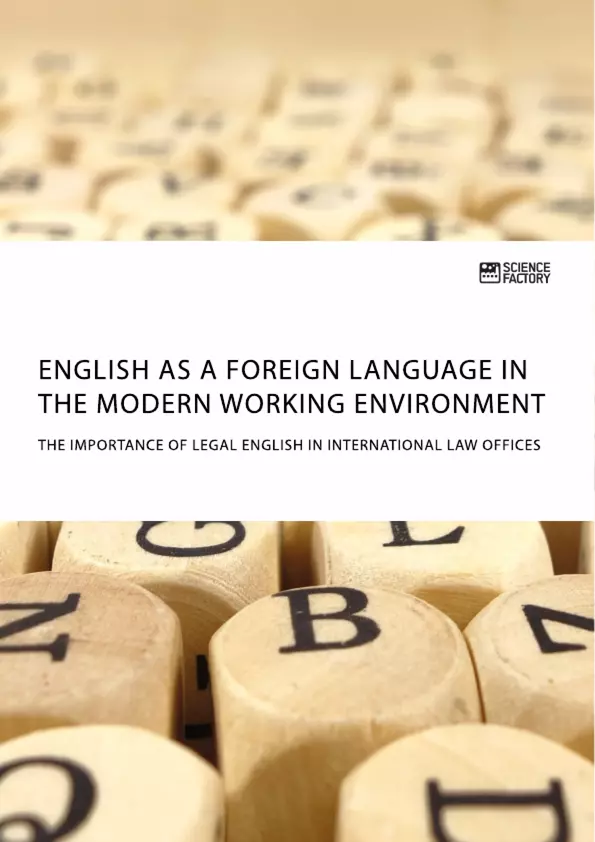
English as a foreign language in the modern working environment. The importance of Legal English in international law offices
Fachbuch, 2019
85 Seiten
Leseprobe
Table of Contents
- 1 Introduction
- 2 Problem statement
- 3 Theoretical Part
- 3.1 Definition of legal English
- 3.2 Historical Background
- 3.3 Differences between general English and Legal English
- 3.4 Benefits of using Business English in International law firms
- 3.5 Disadvantages of using Business English in International law firms
- 4 Methodical Part
- 4.1 Theoretical Background
- 4.2 Exploratory questions and hypotheses
- 4.3 Operationalization
- 4.4 Data inquiry
- 4.5 Data analysis
- 5 Results
- 5.1 Canada
- 5.2 India
- 5.3 Russia
- 5.4 China
- 5.5 Japan
- 5.6 Brazil
- 5.7 South Korea
- 5.8 Germany
- 6 Discussion
- 6.1 Differences between the countries in regard to legal language
- 6.2 Similarities between the countries in regard to legal language
- 7 Summary
- 8 Recommendation for action
- 8.1 Training for young professionals
- 8.2 Training for advanced professionals
- 9 Prospects
Objectives and Key Themes
This work aims to analyze the importance of Legal English in the modern international law office environment. It investigates the differences between general English and Legal English, exploring the advantages and disadvantages of using Legal English in various international contexts. The study also examines the practical application of Legal English in different countries.
- The role of Legal English in international law firms.
- Comparative analysis of Legal English usage across different countries.
- The benefits and drawbacks of utilizing Legal English in international legal practice.
- Methodological approaches to researching Legal English proficiency and application.
- Recommendations for improving Legal English training and education.
Chapter Summaries
1 Introduction: This introductory chapter sets the stage for the entire study, outlining the growing importance of English, specifically Legal English, in the globalized legal profession. It establishes the need for this research by highlighting the challenges and opportunities presented by the increasing internationalization of legal work and the communication barriers that can arise from differing levels of English proficiency. The chapter likely provides context and a brief overview of the research questions that will be explored in subsequent sections.
2 Problem statement: This chapter details the core problem this study addresses – namely, the communication challenges and potential legal risks associated with inadequate Legal English skills within international law firms. It probably elaborates on the specific difficulties faced by legal professionals in different countries when dealing with English-language legal documents, procedures, and client interactions. The chapter likely underscores the significance of addressing this gap in legal education and training.
3 Theoretical Part: This section dives into the theoretical foundations of Legal English. It likely begins by defining Legal English and tracing its historical development, highlighting its unique characteristics and vocabulary compared to general English. This part probably analyzes the advantages of proficient Legal English usage in international law firms, such as improved communication, efficiency, and enhanced client relations, but also explores potential disadvantages, perhaps highlighting the risk of misinterpretations and the importance of cultural sensitivity.
4 Methodical Part: This chapter describes the research methodology employed in the study. It would outline the theoretical underpinnings of the chosen approach, detailing the research questions and hypotheses. The operationalization of concepts and the data collection methods (likely including interviews and case studies), as well as data analysis techniques, are comprehensively explained. This ensures transparency and allows readers to critically evaluate the research’s validity and reliability.
5 Results: This chapter presents the findings of the study, presenting a country-by-country analysis of Legal English usage in various regions (Canada, India, Russia, China, Japan, Brazil, South Korea, and Germany). Each country’s section probably provides a detailed account of the observed practices, highlighting common themes and unique challenges regarding Legal English proficiency and its application within their respective legal systems. The findings likely include specific examples from data collected.
6 Discussion: This chapter interprets the results presented in Chapter 5. It will probably identify and discuss significant differences between countries in their approaches to legal language and the use of English. Furthermore, it would likely highlight similarities among countries, identifying common challenges and successful strategies related to Legal English use in international legal practice. This analysis provides valuable insights and contextualizes the findings within broader theoretical and practical frameworks.
Keywords
Legal English, international law, business English, legal communication, cross-cultural communication, legal education, language proficiency, comparative legal studies, international law firms, legal risk management.
Frequently Asked Questions about: Comprehensive Language Preview of Legal English in International Law Firms
What is the purpose of this document?
This document provides a comprehensive preview of a study analyzing the importance of Legal English in modern international law firm environments. It includes the table of contents, objectives and key themes, chapter summaries, and keywords.
What topics are covered in this study?
The study investigates the differences between general English and Legal English, exploring the advantages and disadvantages of using Legal English in various international contexts. It examines the practical application of Legal English in different countries, focusing on the role of Legal English in international law firms, and offers recommendations for improving Legal English training and education.
What is the structure of the study?
The study is structured into several chapters: Introduction, Problem Statement, Theoretical Part (including definitions, historical background, and comparison of general and legal English), Methodological Part (describing the research approach and data analysis), Results (presenting a country-by-country analysis), Discussion (comparing and contrasting findings across countries), Summary, Recommendations for action (focused on training for young and advanced professionals), and Prospects.
Which countries are included in the country-by-country analysis?
The country-by-country analysis includes Canada, India, Russia, China, Japan, Brazil, South Korea, and Germany.
What are the key themes explored in this research?
Key themes include the role of Legal English in international law firms; comparative analysis of Legal English usage across different countries; benefits and drawbacks of utilizing Legal English; methodological approaches to researching Legal English proficiency; and recommendations for improving Legal English training and education.
What are the key findings (in summary)?
The key findings are presented in a country-by-country analysis in Chapter 5, followed by a discussion of similarities and differences across these countries in Chapter 6. Specific details of the findings are not provided in this preview.
What recommendations are made in the study?
The study offers recommendations for improving Legal English training, focusing on tailored training programs for both young and advanced legal professionals.
What are the keywords associated with this research?
Keywords include: Legal English, international law, business English, legal communication, cross-cultural communication, legal education, language proficiency, comparative legal studies, international law firms, legal risk management.
What is the overall goal of the research?
The overall goal is to analyze the importance of Legal English in the modern international law office environment and to offer practical recommendations for improving legal professionals' proficiency and skills in this area.
Where can I find the full study?
The full study is not included in this preview. This document serves as an overview of the research's contents.
Details
- Titel
- English as a foreign language in the modern working environment. The importance of Legal English in international law offices
- Autor
- Anonym (Autor:in)
- Erscheinungsjahr
- 2019
- Seiten
- 85
- Katalognummer
- V460896
- ISBN (eBook)
- 9783956879890
- ISBN (Buch)
- 9783956879906
- Sprache
- Englisch
- Schlagworte
- Jura Englisch Recht Marketing Personalentwicklung Coaching Wirtschaftspsychologie BWL Management Business English lawyer young professional organizational psychology adult education
- Produktsicherheit
- GRIN Publishing GmbH
- Preis (Ebook)
- US$ 40,99
- Preis (Book)
- US$ 52,99
- Arbeit zitieren
- Anonym (Autor:in), 2019, English as a foreign language in the modern working environment. The importance of Legal English in international law offices, München, Page::Imprint:: GRINVerlagOHG, https://www.diplomarbeiten24.de/document/460896
- Autor werden
- Ihre Optionen
- Vertriebskanäle
- Premium Services
- Autorenprofil
- Textarten und Formate
- Services für Verlage, Hochschulen, Unternehmen

- © GRIN Publishing GmbH.
- Alle Inhalte urheberrechtlich geschützt. Kopieren und verbreiten untersagt.
- info@grin.com
- AGB
- Open Publishing
Der GRIN Verlag hat sich seit 1998 auf die Veröffentlichung akademischer eBooks und Bücher spezialisiert. Der GRIN Verlag steht damit als erstes Unternehmen für User Generated Quality Content. Die Verlagsseiten GRIN.com, Hausarbeiten.de und Diplomarbeiten24 bieten für Hochschullehrer, Absolventen und Studenten die ideale Plattform, wissenschaftliche Texte wie Hausarbeiten, Referate, Bachelorarbeiten, Masterarbeiten, Diplomarbeiten, Dissertationen und wissenschaftliche Aufsätze einem breiten Publikum zu präsentieren.
Kostenfreie Veröffentlichung: Hausarbeit, Bachelorarbeit, Diplomarbeit, Dissertation, Masterarbeit, Interpretation oder Referat jetzt veröffentlichen!
- GRIN Verlag GmbH
-
- Nymphenburger Str. 86
- 80636
- Munich, Deutschland
- +49 89-550559-0
- +49 89-550559-10
- info@grin.com
-









